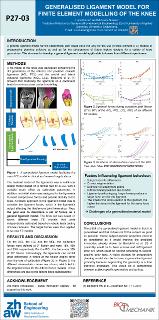Please use this identifier to cite or link to this item:
https://doi.org/10.21256/zhaw-28424| Publication type: | Conference poster |
| Type of review: | Peer review (abstract) |
| Title: | Generalised ligament model for finite element modelling of the knee |
| Authors: | Kiener, Luca Nusser, Michaela |
| et. al: | No |
| DOI: | 10.21256/zhaw-28424 |
| Conference details: | XXIX Congress of International Society of Biomechanics (ISB), Fukuoka, Japan, 30 July - 3 August 2023 |
| Issue Date: | Jul-2023 |
| Publisher / Ed. Institution: | ZHAW Zürcher Hochschule für Angewandte Wissenschaften |
| Language: | English |
| Subjects: | Generalized ligamet model; Knee; Finit element |
| Subject (DDC): | 571: Physiology and related subjects 610.28: Biomedicine, biomedical engineering |
| Abstract: | Introduction: A general ligament model for the tibiofemoral joint would pave the way for the use of finite element (FE) models in preoperative planning software as well as for the development of future implant designs for a variety of knee geometries. The aim was to develop a general ligament model applicable to knees from different specimens. Method: A FE model of the knee was developed containing the 3D geometries of the anterior and posterior cruciate ligaments (ACL, PCL) and the medial and lateral collateral ligaments (MCL, LCL). Beidokhti et al. showed that modelling the ligaments as a continuum leads to more accurate contact modelling. The material model of the ligaments was a multilinear elastic model based on a tensile test on a LCL with a variable strain offset as calibration parameter. In addition, an initial strain was assigned to the ligaments to avoid compressive forces and provide stability to the knee. A holistic approach to the ligament model was to consider the ligament forces, which is the ligament’s output affecting the tibiofemoral joint kinematics. Thus, the goal was to determine a set of forces as a general ligament model. The force set was based on seven different knee FE models that were independently calibrated based on robotic laxity testing of knee cadavers. The target forces were then applied to six new FE models. Results and discussion: For the ACL, the LCL and the MCL, the calibration forces were defined at 0° flexion and were 15N, 49N and 23N, respectively. For the PCL, the force was 35N at 90° flexion. Interestingly, the ligaments can exhibit large differences in forces at the flexion angles other than the one of calibration (Figure 2). In Figure 3, the different stress-strain curves are shown, which led to the targeted forces for the different knee models. These differences are due to the factors listed subsequently. Factors influencing ligament behaviour: • Subject-specific differences • Correct segmentation • Definition of attachment points • Different initial positions due to MRI • Ligament positioning e.g. larger knees produce a larger lever arm for the ligament • The smaller the cross-section of the ligament, the higher the stress in the ligament for the same force output → Challenges of a generalised material model Conclusions: The pitfall of a generalised ligament model is that it is generalised and that it does not fit the subject as good as possible. Hence subject-specific properties need to be considered as it would improve the predicted kinematics already shown by Beidokhti et al. A possibility would be to have a loose and stiff ligament force set, which could be applied according to subjectspecific laxity tests. A viable strategy for preoperative planning would also be to have a generative ligament geometry because segmenting the geometry is a time intensive procedure. This would be a compromise between subject-specific geometries and springs. |
| URI: | https://digitalcollection.zhaw.ch/handle/11475/28424 |
| Fulltext version: | Published version |
| License (according to publishing contract): | Licence according to publishing contract |
| Departement: | School of Engineering |
| Organisational Unit: | Institute of Mechanical Systems (IMES) |
| Published as part of the ZHAW project: | Entwicklung einer unikondylären Kniegelenksprothese mit physiologischer Kinematik |
| Appears in collections: | Publikationen School of Engineering |
Files in This Item:
| File | Description | Size | Format | |
|---|---|---|---|---|
| 2023_Kiener-etal_ESB2023-Poster-Knee-modelling.pdf | 969.84 kB | Adobe PDF |  View/Open |
Show full item record
Kiener, L., & Nusser, M. (2023, July). Generalised ligament model for finite element modelling of the knee. XXIX Congress of International Society of Biomechanics (ISB), Fukuoka, Japan, 30 July - 3 August 2023. https://doi.org/10.21256/zhaw-28424
Kiener, L. and Nusser, M. (2023) ‘Generalised ligament model for finite element modelling of the knee’, in XXIX Congress of International Society of Biomechanics (ISB), Fukuoka, Japan, 30 July - 3 August 2023. ZHAW Zürcher Hochschule für Angewandte Wissenschaften. Available at: https://doi.org/10.21256/zhaw-28424.
L. Kiener and M. Nusser, “Generalised ligament model for finite element modelling of the knee,” in XXIX Congress of International Society of Biomechanics (ISB), Fukuoka, Japan, 30 July - 3 August 2023, Jul. 2023. doi: 10.21256/zhaw-28424.
KIENER, Luca und Michaela NUSSER, 2023. Generalised ligament model for finite element modelling of the knee. In: XXIX Congress of International Society of Biomechanics (ISB), Fukuoka, Japan, 30 July - 3 August 2023. Conference poster. ZHAW Zürcher Hochschule für Angewandte Wissenschaften. Juli 2023
Kiener, Luca, and Michaela Nusser. 2023. “Generalised Ligament Model for Finite Element Modelling of the Knee.” Conference poster. In XXIX Congress of International Society of Biomechanics (ISB), Fukuoka, Japan, 30 July - 3 August 2023. ZHAW Zürcher Hochschule für Angewandte Wissenschaften. https://doi.org/10.21256/zhaw-28424.
Kiener, Luca, and Michaela Nusser. “Generalised Ligament Model for Finite Element Modelling of the Knee.” XXIX Congress of International Society of Biomechanics (ISB), Fukuoka, Japan, 30 July - 3 August 2023, ZHAW Zürcher Hochschule für Angewandte Wissenschaften, 2023, https://doi.org/10.21256/zhaw-28424.
Items in DSpace are protected by copyright, with all rights reserved, unless otherwise indicated.